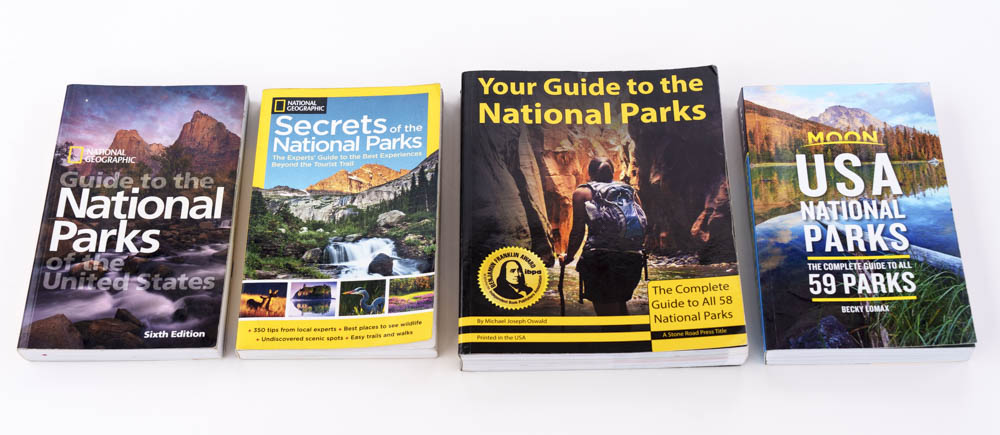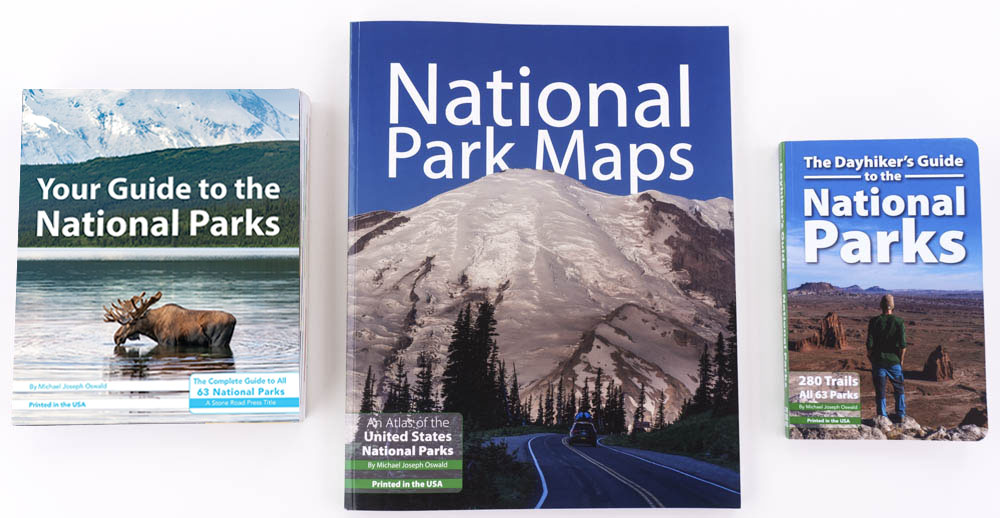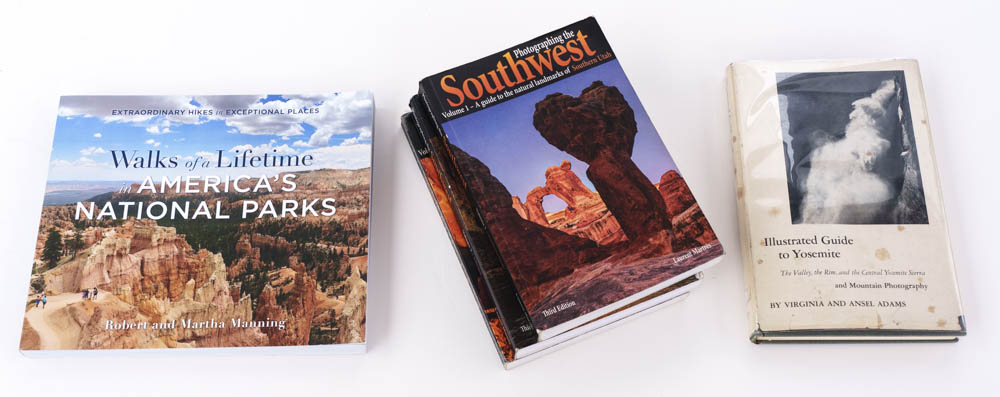The Best National Parks Guidebooks
6 Comments
National Park Week is upon us. My past write-ups acknowledged the role government and citizen organizations played in protecting our national parks. One of the takeaways from Ken Burns and Dayton Duncan’s The National Parks: America’s Best Idea was that their establishment also owes much to the tireless efforts of individual dedicated conservationists. However, the legacy of our national parks is not solely shaped by their creation but also by the ongoing work of individuals who help visitors navigate and appreciate their wonders. Although unheralded, guidebook writers have offered invaluable guidance and insight to readers. Through their meticulous research, they have enriched the experiences of countless people, including me.
Today, I will highlight the books of one guidebook writer, Michael Joseph Oswald, and briefly compare them with some other favorite park books for context. Besides his accomplishments, Michael is a kindred spirit and generous person who helps promote other creatives and small business owners in the national park space. I contacted Micheal in 2016 with questions about book distribution, which he answered by phone and email. His referral led to an offer from his distributor, but I signed up with Ingram instead, and a few years later, Michael made the switch, so our books are now distributed by the same company, PGW (part of Ingram). Our more important commonalities are that we single-handedly author books that cover all 63 U.S. National Parks with writing, photographs, and maps. We both self-publish. Although one would think that our one-man operations make it impossible for us to compete with well-established publishers, Michael’s Your Guide to the National Parks sales have been comparable to the National Geographic’s classic Guide to the National Parks, while Treasured Lands is the best-selling photography book about the national parks, currently in its 8th printing.

Your Guide to the National Parks (now in its third edition) was a remarkable debut book in 2012 given its encyclopedic scope. Larger and with more information in it than in any other guidebook, there is something for everybody: history, fun facts, top sights, itineraries; tables with lodging, camping, and trails; weather; readable and useful maps; and resources. Yet, the book reflects in its superior organization the analytical mind of a former engineer. The main shortcoming of other park guidebooks available at that time was that they were mostly for automobile touring. Even the best of them, National Geographic’s Guide to the National Parks was structured around road itineraries. By contrast, Your Guide to the National Parks rightly emphasized hiking and other outdoor activities. Michael may have single-handedly shaken the industry, as the new park guidebooks available today have followed his approach. For example, the more recent National Geographic’s Secrets of the National Parks, which doesn’t reveal secrets, is a marked improvement but does not try to be comprehensive. Moon USA National Parks offers an excellent balance of information and inspiration through design and high-quality photographs. Speaking of photographs, more than forty of mine were included in the National Geographic’s guide pictured above. On the other hand, unlike others, Your Guide to the National Parks uses photos from free sources – demonstrating why “pro” landscape photography still has a place. Regardless of how the industry as caught up, Your Guide to the National Parks continues to distinguish itself from other guidebooks by being mostly the product of his travels park-to-park, doing the activities described in the book, and collecting testimonials from park rangers and visitors. There is something special about a single voice speaking from experience. Like me, Michael traveled frugally, sleeping in his car and tent. His book is offered at an incredibly low price for what you get, a 7.25″ x 8.75″ book of 724 pages – again not unlike Treasured Lands.

Compared to other guidebooks with a trim of about 5.5″ x 8.5″, the maps in Your Guide to the National Parks are more readable, but National Park Maps: An Atlas of the U.S. National Parks takes it one step further. In that book of trim 10.75″ x 13.5″ maps are reproduced 30% larger than the 8.25″ wide unigrid brochures provided by the National Park Service, which given the density of information in the NPS maps, is useful. Unlike the National Geographic Atlas of the National Parks, which is a hefty coffee-table full of great photos, fascinating narratives and data but includes passable maps, the meat of the portable and inexpensive National Park Maps are the maps, together with some eminently practical visitor information, driving distance tables, favorite lists, and itineraries. The author has been criticized for “plagiarizing” the National Park Service (NPS) maps, but I think he made the right choice, as those maps are the most informative around, a testament to the excellence of the NPS media services. Since those maps are public domain, like everything produced by the U.S. Government, there is no need to reinvent the wheel and end up with worse maps as other publishers have done in their books. Besides, Michael has added a layer of information, and in some cases has improved the maps themselves. Witness how the NPS maps of Redwood National Park, Cuyahoga Valley National Park, and Indiana Dunes National Park all lack shaded relief, and how National Park Maps has remedied that shortcoming. NPS maps can be downloaded from nps.gov or the more user-friendly repository npmaps.com, and if you contact a NPS unit, they will generally (but not always) mail you the relevant brochure/visitor guide/map. Still, the convenience of having all the maps in an atlas and the bonus information make National Park Maps worth it.
One of the strengths of Your Guide to the National Parks is that it provides more hiking information than other guidebooks. The Dayhiker’s Guide to the National Parks expands on that aspect. I believe parks are best experienced on foot and directly immersed in nature, and due to the weight of my camera equipment, I generally favor day hikes over backpacking trips. Therefore, it is the book I wish I had when I first started visiting America’s national parks. I have already mentioned that other guides to all the national parks tend to emphasize driving tours. There is now an abundant literature of hiking guides devoted to the trails of a specific park. Falcon Guides covers many areas, but the best guidebooks are locally self-published, such as Eric Stensland’s Hiking Rocky Mountain National Park. Yet for someone on a national park trip, those books offer overwhelming options, and several books would be needed. Instead The Dayhiker’s Guide to the National Parks presents a carefully curated selection of 280 trails, expertly described and mapped, ensuring that hikers can experience each park’s highlights on day hikes. The book serves as a comprehensive, yet self-contained, concise, and portable guide (a small paperback with rounded corners) to all the parks. The 198 topographic maps within are sufficient to follow park trails since they are generally well-marked. Robert and Martha Manning’s Walks of a Lifetime in America’s National Parks is in the same spirit, offering a selection of trails in each national park from a pair of veteran hikers, but it lacks maps or precise information such as elevation gain, and its format of soft-cover coffee-table book is not as practical.

Besides those just mentioned, I own an entire shelf of national park books (some reviewed here and here). It is a rare instance when browsing does not lead to new ideas for places to explore, as each author emphasizes their interests. For photography location information, my two main sources of information are not specific to national parks, although the national parks are prominent among the locations described. In the past, I have subscribed to Robert Hitchman’s Photograph America Newsletter. He has been publishing them for 35 years without missing a beat, and the complete collection is an excellent value with solid information. The Phototrip USA series is excellent, and in particular, the three Southwest volumes authored by Laurent Martres are by far the most detailed and comprehensive resource on photographing that region. It is a work whose breadth and depth are unlikely to be replicated by anyone.
Ansel Adams is of course revered for his masterful photographs of Yosemite, which he published in many popular books. However, his first publication about Yosemite was not a photography book, but rather the Illustrated Guide to Yosemite Valley (1940) authored together with his wife Virginia and later expanded into the Sierra Club’s Illustrated Guide To Yosemite (1963). Preceding Michael’s approach before his lifetime, the Adams conceived the guidebook as being about “ecological recreation – something to be enjoyed best when one gets out and walks”. As we expect from Ansel, included are notes on photography, described as a way of “crystalizing” one’s experience. Since the books on my shelves have enriched my experience of our national parks, I have tried to pass that forward, envisioning Treasured Lands as an informative and useful book. Even though three-fourths of the pages are filled up with photographs in a design that honors them, I managed to squeeze in 140,000 words. Of all the feedback I received from readers, maybe the most gratifying has been to hear that the book enriched their experience of our national parks. I hope that one of the books mentioned in this article will do that for you.


Good post. I have been a long time subscriber to Bob’s newsletter and echo your thoughts on it as well as Laurent’s Southwest series.
Because of that I look forward to getting all 3 of Oswald’s books shortly. Thanks for covering this.
Thanks! Keep in mind that while Oswald’s books are excellent for their general purpose, they don’t offer the more specific information found in the two resources you mentioned – and to some extent in Treasured Lands.
I can recommend Colleen Miniuk’s guide to photographing Acadia National park, and James Kaiser’s general guide to the park and surrounding area towns. Both are available on Amazon.
Thanks for the recommendations, Ignacio. Colleen Miniuk’s guide did point me out to some places I would have missed otherwise. James Kaiser’s guides are good combination of writing and photography. Michael said that they inspired him to create a guide for all the parks. However, in this post, I have kept the focus away from guides to individual parks.
Granted, but I get the feeling that some broad-focus guides tend to slight the smaller parks in favor of the “blockbusters.”
I meant to add that smaller, individualized guides are easier to take along when actually visiting a particular park.